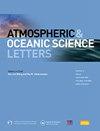The strongest early-summer drought–flood abrupt alternation event over the Huang–Huai–Hai River Basin in 2024 since the 1980s: Perspective of anomalous subseasonal circulation evolution
IF 3.2
4区 地球科学
Q3 METEOROLOGY & ATMOSPHERIC SCIENCES
引用次数: 0
Abstract
Since the 21st century, the Huang–Huai–Hai River Basin (HHHRB) in China has experienced increased frequency and severity of drought–flood abrupt alternation (DFAA) events during early summer, characterized by droughts in June followed by floods in July. The 2024 event was the most severe since 1981. This study demonstrates that such compound extreme events are closely linked to anomalous subseasonal evolution of large-scale atmospheric circulation. During the drought phase, the East Asian subtropical westerly jet (EAJ) shifts southward, and the western Pacific subtropical high (WPSH) exhibits anomalous strengthening with its western ridge line displaced southward. The flood phase is characterized by acceleration of the EAJ, westward extension of the WPSH, and enhanced southwestern moisture transport from the western Pacific. Beyond these typical features, the 2024 early summer circulation exhibited unique characteristics: Anomalous northeastward intensification of the WPSH facilitated merged moisture influx from both the Indian Ocean and the western Pacific along the southeast pathway into the HHHRB in July, resulting in the highest net moisture inflow at the southern boundary of the HHHRB since 1981. The synergistic effects of multiple factors primarily explain the exceptionally intense DFAA event in 2024.
摘要
21世纪以来, 中国黄淮海地区初夏旱涝急转事件 (6月旱–7月涝) 呈频次增多, 强度增强趋势, 2024年事件为1981年以来最强. 研究表明, 此类复合极端事件与大尺度环流的季节内异常演变密切相关, 其中旱期表现为东亚副热带西风急流的位置偏南, 西太副高的强度偏强但西段脊线偏南; 涝期表现为东亚副热带西风急流增速, 西太副高西伸脊点偏西与西南路径西太水汽的增多. 除上述典型特征外, 2024年初夏的环流演变兼具特殊性——初夏西太副高向东北方向的异常加强, 导致7月印度洋水汽和东南路径的西太水汽合并汇入黄淮海地区, 造成其南边界水汽净流入量达1981年以来峰值. 以上多要素协同是2024年黄淮海地区旱涝急转事件强度异常偏强的重要原因.

20世纪80年代以来2024年黄淮海流域最强的早夏旱涝突变事件:异常亚季节环流演变的视角
21世纪以来,中国黄淮海流域初夏旱涝突变(DFAA)发生频率和严重程度均呈上升趋势,表现为6月旱后7月涝。2024年的地震是1981年以来最严重的一次。研究表明,这种复合极端事件与大尺度大气环流的亚季节异常演变密切相关。干旱期东亚副热带西风急流(EAJ)南移,西太平洋副热带高压(WPSH)异常增强,西脊线南移。洪水期表现为东亚副热带加速,副高西伸,西太平洋向西南输送水汽增强。除了这些典型特征外,2024年初夏环流还表现出独特的特征:西高压东北方向的异常增强促进了印度洋和西太平洋沿东南路径的水汽流入,导致7月西高压南部边界的净水汽流入达到1981年以来的最高水平。多因素的协同效应是2024年DFAA异常强烈的主要原因。摘要21世纪以来, 中国黄淮海地区初夏旱涝急转事件 (6月旱–7月涝) 呈频次增多, 强度增强趋势, 2024年事件为1981年以来最强. 研究表明, 此类复合极端事件与大尺度环流的季节内异常演变密切相关, 其中旱期表现为东亚副热带西风急流的位置偏南, 西太副高的强度偏强但西段脊线偏南; 涝期表现为东亚副热带西风急流增速, 西太副高西伸脊点偏西与西南路径西太水汽的增多. 除上述典型特征外, 2024年初夏的环流演变兼具特殊性——初夏西太副高向东北方向的异常加强, 导致7月印度洋水汽和东南路径的西太水汽合并汇入黄淮海地区, 造成其南边界水汽净流入量达1981年以来峰值. 以上多要素协同是2024年黄淮海地区旱涝急转事件强度异常偏强的重要原因.
本文章由计算机程序翻译,如有差异,请以英文原文为准。
求助全文
约1分钟内获得全文
求助全文
来源期刊

Atmospheric and Oceanic Science Letters
METEOROLOGY & ATMOSPHERIC SCIENCES-
CiteScore
4.20
自引率
8.70%
发文量
925
审稿时长
12 weeks
 求助内容:
求助内容: 应助结果提醒方式:
应助结果提醒方式:


